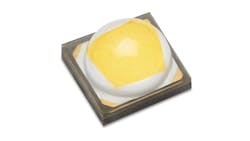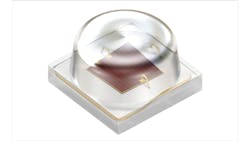Lumileds has announced an upgrade to the Luxeon HL2X portfolio of packaged LED that delivers 330 lm or more depending on CCT and drive current, and targets demanding solid-state lighting (SSL) applications. Meanwhile in horticultural SSL, ams Osram has expanded its portfolio of LEDs with a family of products that include batwing optics and also one product with the new Horti White phosphor. And researchers in Singapore have discovered a new way of generating longer-wavelength monochromatic light more efficiently using InGaN (indium gallium nitride) technology.
Lumileds portfolio upgrade
The upgraded Lumileds HL2X comes following the initial launch of that product line in the summer of 2020. The product line was targeted at demanding applications such as street lights from the start, and in fact at the start the company only offered cool-CCT options and low CRI performance. Lumileds has subsequently added warm CCT options down to 2700K and better CRI options topping out at 90.
The HL2X was essentially a drop-in upgrade from the Luxeon TX family, both utilizing a 3535 (3.5×3.5-mm) package footprint. To scale performance from the TX, Lumileds moved to an architecture that relied on the company’s chip-scale package (CSP) HL1 LED announced in 2019. That die with a patterned sapphire substrate offered an improved performance path from the TX, and additional performance improvements in the latest upgrade have resulted in Lumileds targeting sports venue lighting with the portfolio.
“Luminaire manufacturers rely on four key factors: performance, reliability, ecosystem, and availability,” said Noman Rangwala, director of strategic marketing and business development at Lumileds. “Luxeon HL2X performance and reliability are clear winners in the high-power LED segment. A broad and rich ecosystem — from boards to drivers, optics, and assembly are in place. And we have invested to be able to deliver on time with standard lead times. Bottom line, Luxeon HL2X is a solution that manufacturers can count on.”
Lumileds continues to specify LED performance at a practical 85°C to provide product designers with a realistic expectation of performance in an application. Moreover, the upgraded HL2X is backed by more than 12,000 hours of LM-80 test data and has demonstrated very low lumen and color shift. The new products are available immediately.
Osram horticultural LEDs
Swapping application areas significantly, the Osram Opto Semiconductors group’s latest announcement is focused on SSL for plant growth. The company says most horticultural LEDs have either an optic that produces a Lambertian beam distribution or perhaps no optic with the requirement of a secondary diffuser. In either case, Osram says such an optical system results in a nonuniform beam with hot spots.
The primary optic with a batwing distribution in the Oslon Square Batwing family delivers a broader and more uniform beam to the plant canopy. Osram has previously touted the advantages of its Oslon Square LEDs for horticultural applications including a more efficient Hyper Red model. Now the company has combined the efficiency advantages of the square architecture in Hyper Red (660 nm), Deep Blue (450 nm), Far Red (730 nm), and Horti White while also adding the batwing primary optics. The Hyper Red model delivers wall plug efficiency of 74% with 1042 mW of radiometric power produced at 700 mA.
The Horti White model is also a significant advancement. Many growers have found that broad-spectrum white LEDs are best with some cultivars and also provide the advantage of a better workspace for growers that can better see the plants and spot pathogens early on. At our HortiCann Light + Tech event a few months back, Osram did a presentation that was largely focused on Horti White technology. The company has devised a single phosphor that can deliver the broad spectrum plants need and that enables growers to see well under the lights. Meanwhile, the single-phosphor architecture cuts the bill of materials cost and simplifies manufacturing. If you want to learn more about Horti White, catch the HortiCann archive, but do so quickly because it will only be available a few more weeks.
SMART research in Singapore
We’ll close with a brief mention of LED research being undertaken in Singapore by the Low Energy Electronic Systems (LEES) group at the Singapore-MIT Alliance for Research and Technology (SMART) enterprise that combines the talent of Massachusetts Institute of Technology (MIT), the National University of Singapore, and Nanyang Technological University. We rarely cover early-stage research, but this work could ultimately impact the way white LED light is made in applications ranging from general lighting to horticultural lighting to other life sciences.
The LEES team says it has found a way to generate red, orange, yellow, and other longer wavelengths using the intrinsic defects in semiconductor materials. Typically, InGaN technology can generate purple or blue light. Less-efficient AlGalnP (aluminum gallium indium phosphide) is typically used for the longer wavelengths. The InGaN efficiency advantage is a primary reason the industry uses a blue pump and phosphor to make white light rather than mixing light from monochromatic emitters. The LEES team hopes to change all that and has published a paper on the research.
For up-to-the-minute LED and SSL updates, why not follow us on Twitter? You’ll find curated content and commentary, as well as information on industry events, webcasts, and surveys on our LinkedIn Company Page and our Facebook page.







